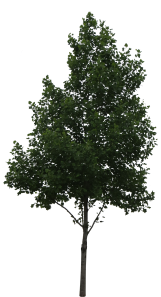Quercus rubra

Under optimal conditions and full sun, northern red oak is fast growing and a 10-year-old tree can be 5–6 m (16–20 ft) tall.[4] Trees may live up to 400 years[5] and a living example of 326 years was noted in 2001.
Northern red oak is easy to recognize by its bark, which features ridges that appear to have shiny stripes down the center. A few other oaks have bark with this kind of appearance in the upper tree, but the northern red oak is the only tree with the striping all the way down the trunk.
As with most other deciduous oaks, leafout takes place in spring when day length has reached 13 hours—it is tied entirely to photoperiod and will take place regardless of air temperature. As a consequence (see below), in cooler regions, northern red oaks often lose their flowers to late spring frosts, resulting in no seed crop for the year. The catkins and leaves emerge at the same time. The acorns develop on the tree for two growing seasons and are released from the tree in early October, and leaf drop begins when day length falls under 11 hours. The timing of leafout and leaf drop can vary by as much as three weeks in the northern and southern US. Seedlings emerge in spring when soil temperatures reach 21 °C (70 °F).
